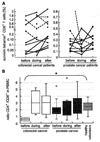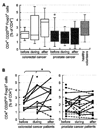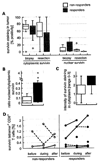T-cell responses to survivin in cancer patients undergoing radiation therapy
- PMID: 18676762
- PMCID: PMC2748652
- DOI: 10.1158/1078-0432.CCR-07-4462
T-cell responses to survivin in cancer patients undergoing radiation therapy
Abstract
Purpose: The goal of this study was to determine if radiation therapy (RT) of human cancer enhances or diminishes tumor-specific T-cell reactivity. This is important if immunotherapy is to be harnessed to improve the outcome of cancer radiotherapy.
Experimental design: Lymphocytes were isolated from colorectal cancer (CRC) patients before, during, and after presurgical chemoradiotherapy. Similar samples were taken from prostate cancer patients receiving standard RT. The level of CD8(+) T cells capable of binding tetramers for the tumor-associated antigen survivin, which is overexpressed in both cancer types, was enumerated in HLA-A*0201 patient samples. CD4(+), CD25(high), Foxp3(+) cells were also enumerated to evaluate therapy-induced changes in T(regulatory) cells. For CRC patients, most of whom were enrolled in a clinical trial, pathologic response data were available, as well as biopsy and resection specimens, which were stained for cytoplasmic and intranuclear survivin.
Results: Survivin-specific CD8(+) T lymphocytes were detected in the peripheral blood of CRC and prostate cancer patients and increased after therapy in some, but not all, patients. Increases were more common in CRC patients whose tumor was downstaged after chemoradiotherapy. Biopsy specimens from this cohort generally had higher nuclear to cytoplasmic survivin expression. T(regulatory) cells generally increased in the circulation following therapy but only in CRC patients.
Conclusion: This study indicates that RT may increase the likelihood of some cancer patients responding to immunotherapy and lays a basis for future investigations aimed at combining radiation and immunotherapy.
Conflict of interest statement
No potential conflicts of interest were disclosed.
Figures




References
-
- Chakraborty M, Abrams SI, Coleman CN, Camphausen K, Schiom J, Hodge JW. External beam radiation of tumors alters phenotype of tumor cells to render them susceptible to vaccine-mediated T-cell killing. Cancer Res. 2004;64:4328–4337. - PubMed
-
- Teitz-Tennenbaum S, Li Q, Rynkiewicz S, et al. Radio-therapy potentiates the therapeutic efficacy of intratumoral dendritic cell administration. Cancer Res. 2003;63:8466–8475. - PubMed
-
- Chiang CS, Hong JH, Wu YC, McBride WH, Dougherty GJ. Combining radiation therapy with interieukin-3 gene immunotherapy. Cancer Gene Ther. 2000;7:1172–1178. - PubMed
-
- Ambrosini G, Adida C, Altieri DC. A novel anti-apoptosis gene, survivin, expressed in cancer and lymphoma. Nat Med. 1997;3:917–921. - PubMed
Publication types
MeSH terms
Substances
Grants and funding
LinkOut - more resources
Full Text Sources
Medical
Research Materials

